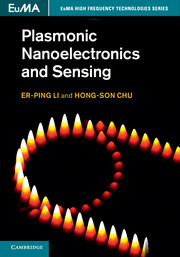Book contents
- Frontmatter
- Contents
- List of contributors
- Preface
- 1 Fundamentals of plasmonics
- 2 Plasmonic properties of metal nanostructures
- 3 Frequency-domain methods for modeling plasmonics
- 4 Time-domain simulation for plasmonic devices
- 5 Passive plasmonic waveguide-based devices
- 6 Silicon-based active plasmonic devices for on-chip integration
- 7 Plasmonic biosensing devices and systems
- Index
- References
7 - Plasmonic biosensing devices and systems
Published online by Cambridge University Press: 05 March 2014
- Frontmatter
- Contents
- List of contributors
- Preface
- 1 Fundamentals of plasmonics
- 2 Plasmonic properties of metal nanostructures
- 3 Frequency-domain methods for modeling plasmonics
- 4 Time-domain simulation for plasmonic devices
- 5 Passive plasmonic waveguide-based devices
- 6 Silicon-based active plasmonic devices for on-chip integration
- 7 Plasmonic biosensing devices and systems
- Index
- References
Summary
To detect an analyte, surface plasmons whose characteristics are sensitive to the refractive-index variations close to the sensor's surface are excited and measured. Binding of the target analyte onto the sensor's surface will cause changes in refractive index and hence in the measured plasmonic characteristics. Depending on what type of surface plasmon is excited (e.g. surface plasmon polariton (SPP), Fano resonance), which plasmonic characteristic is measured/modulated (e.g. resonance wavelength, transmitted light intensity), and in what manner the bio-functionalization (i.e. binding of the target analyte) is performed, there are many different configurations for plasmonic biosensors, which will be reviewed in this chapter. The ultimate goal is to increase the sensor's sensitivity and the figure of merit. To achieve this goal, one must first understand the physics of the resonances, and then implement a smart structural design. In this chapter, two design methods will be introduced: an N-layer model and a finite-element-method (FEM) model, which are further elaborated by presentation of three biosensor design examples.
Introduction
A biosensor is a device for detecting an analyte, which typically combines a biological component with a physiochemical detector. For instance, a blood-glucose biosensor uses the enzyme glucose oxidase to break blood glucose down. In doing so it first oxidizes glucose and uses two electrons to reduce the FAD (a component of the enzyme) to FADH2. Then the FADH2 is oxidized by accepting two electrons from the electrode.
- Type
- Chapter
- Information
- Plasmonic Nanoelectronics and Sensing , pp. 217 - 248Publisher: Cambridge University PressPrint publication year: 2014



